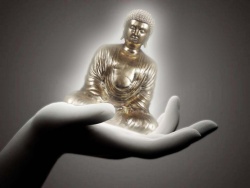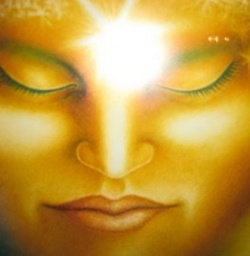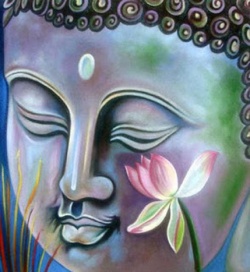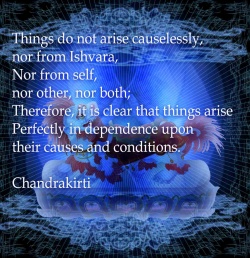Distorted Minds: Faulty Perceptions in the Sautrantika Tenet System
A main focus of Buddhist psychology is the relationship between knowledge and experience.
The Buddha famously constructed the four noble truths as a framework for understanding the relationship between suffering, happiness and behavior.
Though the records of his discourses are replete with personal methods and instructions for working toward the complete cessation of suffering or the cultivation of happiness, he also admonished his followers to test his claims with their own intelligence and experience.)1) .
Since appearances can be deceptive, subsequent followers found it important to have a competent understanding of how to discriminate between true and false knowledge. In the Gelugpa tradition of Tibetan Buddhism, distortions in knowledge are taught in the epistemological framework of Sautrantika philosophy.)2)
In this essay we will briefly explore the main possibilities of error discussed.
The Sautrantika or “Sutra”)3) tenet system is based on the works of the ancient Indian Buddhist masters Dignāga, Dharmakīrti, Vasubandhu, and Asaṅga.)4)
It is both an epistemological and psychological model that is a product of Tibetan Gelugpa scholars’ attempts to categorize the various kinds of views they encountered in the Buddhist sutras and their commentaries.)5)
Considered the most foundational of the four main tenet models used in Gelugpa monastic curriculum,)6) it presents a map of the structure of consciousness, categorizes types of perceptions in respect to how they relate to an object in the world and discusses their relative validity.
Basic to this model is the idea that what we experience as a continuum of mind is actually tiny successive individual moments of mental activity.)7) In other words, what we experience as normal waking consciousness is actually a maelstrom of mind moments.
Just like movies create the appearance of a moving image using short still photographs shown in rapid succession, the torrent of tiny mind moments create our experience. Each moment of “mind” is unique, has its own quality and its own consequences.
The most fundamental division made in Sautrantika is conceptual and non-conceptual mind moments.
Non-conceptual minds arise when an object in the world comes directly into contact with one of our six sensory faculties)8) and their corresponding sense consciousness’.
The objects that exist in the world cast an “aspect” to our sense faculty which is what allows it to appear in a consciousness.
That mind is said to “take on” the aspect, while remaining clear, like a piece of glass sitting on a blue cloth appears to be blue.)9)
A conceptual mind, in contrast, arises abstractly as an “intentional reflection upon an object already presented to the mind by…sense perception”.)10)
Lati Rinpoche says that these minds are “…a determinative knower that apprehends sound and meaning generalities as suitable to be mixed.”)11) In other words, they identify objects by combining linguistic labels and experiences together.
Though mistakes can arise in both kinds of mind, in Sautrantika, proper incontrovertible knowledge about the nature of reality can only be gained through non-conceptual moments of direct perception.
While conceptual knowledge based on logic, reasoning and trustworthy authority is pursued and highly prized; it is considered secondary at best. It is used as a provisional position on which to generate more definitive experiential knowledge.
As Dr. Christopher deCharms explains: “the purpose of direct perception in Sautrantika…is clear and fundamental—it is to gain access to the truth from one’s direct experience of perceivable reality, which is what leads to overcoming ignorance.” )12)
At worst, conceptuality is considered deeply suspect. In fact, some conceptions are considered the root of suffering in general.
Geshe Rabten explains that, actually “…it is a conception, of a fallacious kind, that is responsible for all mentally disturbing thoughts and emotions that in turn motivate the physical, verbal and mental activity that brings about…suffering and discontent.”
This kind of proper understanding is vital to the soteriological aim of Buddhism.
The varieties of mistaken knowledge that lead to suffering must be carefully rooted out and corrected. Since ultimately incontrovertible knowledge is only gained from direct perception and improper conceptuality can lead to disaster, each mind must be carefully inspected.
All of the distorted minds that are commonly presented in the Sautrantika system can be summarized with three basic categories:
(1) invalid objects of knowledge,
(2) mistaken relationship to objects of knowledge and
(3) invalid assumptions about selves.
Though these categories may be helpful, some kinds of errors might belong to more than one.
This first category is invalid objects of knowledge.
This means that we perceive something that isn’t actually there. Lati Rinpoche describes this as those mind moments which “are mistaken with respect to the object they are engaged in, the object which is actually being comprehended.”)13)
The traditional presentation lists four conditions for mistaken non-conceptual minds.
First, the object can deceive us, as in the case of an optical illusion. Second, our sense organs capacities can be damaged, as in the impairments of disease or drugs.
Third, situational distortions, like seeing trees moving as we sit still on a moving train, can deceive us.
Lastly, temperamental impairments, such as being extremely upset, can distort our perception.)14) From a conceptual stand point, there is a huge variety of non-existent things, like rabbits on Mars, which we can conjure in our minds.
These mistaken minds can be as benign as thinking there is more money in our wallet than there is or as harmful as believing that killing someone will solve our problems.
Six sources of conceptual error are generally listed, including focusing on the wrong source of information, misinterpreting situational cues, being clouded by our mood or state of mind, our karmic habits, and false education.)15)
Overall, this level of mistaken knowledge is the most obvious because we often see the problems it causes in our daily life. We can cause disasters for ourselves and others by acting on information which does not conform to reality.
Businesses have failed, relationships have been abandoned, and wars have been fought because people perceived or believed things that didn’t accord with conventional fact.
However, even if we have a concept that is correctly in accord with reality, we may still engage in the next category of distorted mind, a mistaken relationship to our object of knowledge.
As Geshe Tashi puts it, although conceptual minds are “a construct based on a linguistic, generalizing process that has little to do with the actual object before us, this is not the way we see it.
According to our view, the object of our conceptual consciousness is real and accurate.
This is a mistake.”)16) We often don’t realize that our thought is only a thought; we mistake the object of our concept for an objectively existing reality. As deCharms explains, “the mental semblance does not have all of the real object’s own features, nor the real objects richness of detail.”
Some traditional examples of their differences are the fact that concepts are static and unchanging, they can be perceived without the presence of a physical counterpart, and they cannot perform their functions. )17)
For example, a coffee cup can hold many delicious beverages but we cannot drink out of our idea of one, nor will our concept of hot coffee stain a shirt.
Though we may not believe that we engage in this error often, according to Sautrantika, all conceptual minds are mistaken in this way.)18)
Any time we think, plan, or understand we are engaging with abstract, generalized objects that mistakenly appear as the objects they are merely signifying.
This mistake can lead to a lot of unnecessary suffering. Something may be quite unpleasant in reality, but the mere conceptual memory of them does not actually have the capacity to harm us.
For example, while our memory of a person, place or thing may be accurate, because we do not distinguish between a concept and reality properly we suffer mental torment as if it were present.
This mistake cannot be made by non-conceptual direct minds since their objects are necessarily existent, objectively present, functioning things.
The last category of distortion is actually a particular, extremely subtle wrong concept that could just as easily be classified as both an invalid object of knowledge and a distorted relationship. However, invalid assumptions about selves are so important to the Buddhist understanding of suffering that they deserve special mention.
According to Guy Newland, in Sautrantika, total freedom from suffering “…depends on the realization that the person is empty of being substantially existent in the sense of being self-sufficient.”)19)
This particular distorted mind is the opposite notion.
Geshe Tashi Tsering explains that this special kind of innate “…ignorance arises on the basis of the mistaken notion that our ‘self’ is a unitary ‘thing’ that exists in an objective and independent way.
This immensely powerful propensity to see things as independent and intrinsic…is the main reason that we are not enlightened.”)20) It is the immensely important “fallacious” root of suffering which was mentioned above.
In Sautrantika, the “self” is essentially a mistaken concept that we mistake for being real.)21) We view form, feelings, perceptions, mental activities and consciousness’ as if this collection belonged to one, permanent, independent entity. In fact, one of the other translations for this erroneous concept is the “false view of the transitory collection”)22)
This mind is a problem because when we believe ourselves to be independent and self-sufficient we habitually misunderstand the causes of suffering and happiness. We then engage in actions in a way that, from the Buddhist point of view, will always lead to problems.
This ignorance forms the basis for unhealthy attachment and overly aggressive aversion to experiences which are the root factors involved in every imaginable type of mental stress.
In each of the three types of distortion we can create suffering for ourselves and others.
While some types of mistaken knowledge are clearly more harmful than others, for Buddhists using the Sautrantika method, it is important to understand all the mistakes that can be made with both conceptual and non-conceptual minds.
Though the Buddha was extremely careful to teach only what would be helpful to his students, it is also important that we develop our own discriminating intelligence so we can be sure to understand his intent properly.
Proper discrimination between what is wholesome and what is harmful is the most important factor in determining the quality of our present and future existence. The tenet systems of the Gelugpa Tibetan Buddhist monastic curriculum are pedagogically designed to help students develop such intelligence.)23)
Works Cited
Decharms, Christopher. Two Views Of Mind: Abhidharma And Brain Science. Ithaca: Snow Lion, 1997.
Newland, Guy. Appearance And Reality: The Two Truths In The Four Buddhist Tenet Systems. Snow Lion, 2009.
Rabten, Geshe, and Stephen Batchelor. The Mind and Its Functions. 2nd ed. Le Mont-Pelerin: Edition Rabten Choeling, 1992.
Rinbochay, Lati, and Elizabeth Napper. Mind In Tibetan Buddhism. Reprint. Ithaca: Snow Lion, 1981.
Thera, Soma. “Kalama Sutta: The Buddha’s Charter of Free Inquiry.” Access to Insight. Accessed April 19, 2013. http://www.accesstoinsight.org/lib/authors/soma/wheel008.html.
Tsering, Geshe Tashi. Buddhist Psychology: The Foundation of Buddhist Thought. Somerville: Wisdom Publications, 2006.
)1) Soma Thera, “Kalama Sutta: The Buddha’s Charter of Free Inquiry,” Access to Insight, accessed April 19, 2013, http://www.accesstoinsight.org/lib/authors/soma/wheel008.html.
)2) Geshe Rabten and Stephen Batchelor, The Mind and Its Functions, 2nd ed. (Le Mont-Pelerin: Edition Rabten Choeling, 1992), 13.
)3) Guy Newland, Appearance And Reality: The Two Truths In The Four Buddhist Tenet Systems (Snow Lion, 2009), 25.
)4) Lati Rinbochay and Elizabeth Napper, Mind In Tibetan Buddhism, Reprint (Ithaca: Snow Lion, 1981), 12.
)5) Newland, Appearance And Reality, 9.
)6) Ibid., 25.
)7) Christopher Decharms, Two Views Of Mind: Abhidharma And Brain Science (Ithaca: Snow Lion, 1997), 64.
)8) In addition to the five senses (sight, sound, smell, touch, taste), Buddhism posits a sixth “mental” sense.
)9) Decharms, Two Views Of Mind, 71.
)10) Rabten and Batchelor, The Mind and Its Functions, 42.
)11) Rinbochay and Napper, Mind In Tibetan Buddhism, 50.
)12) Decharms, Two Views Of Mind, 64.
)13) Rinbochay and Napper, Mind In Tibetan Buddhism, 24.
)14) Rabten and Batchelor, The Mind and Its Functions, 82–83.
)15) Geshe Tashi Tsering, Buddhist Psychology: The Foundation of Buddhist Thought (Somerville: Wisdom Publications, 2006), 122–123.
)16) Ibid., 99–100.
)17) Decharms, Two Views Of Mind, 67–68.
)18) Rabten and Batchelor, The Mind and Its Functions, 44.
)19) Newland, Appearance And Reality, 32.
)20) Tsering, Buddhist Psychology, 52.
)21) Newland, Appearance And Reality, 33.
)22) Tsering, Buddhist Psychology, 51.
)23) Newland, Appearance And Reality, 9.











